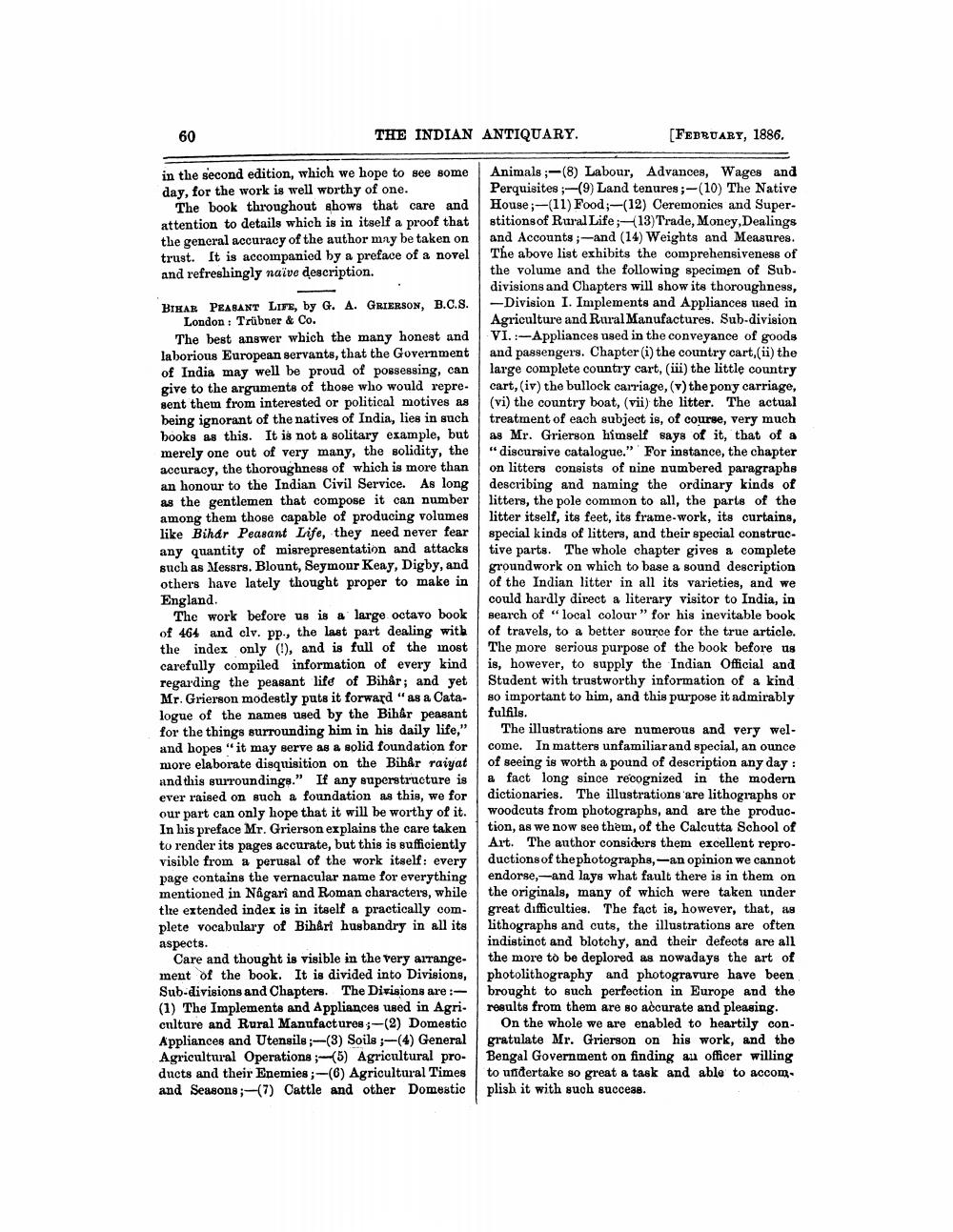________________
60
THE INDIAN ANTIQUARY.
in the second edition, which we hope to see some day, for the work is well worthy of one.
The book throughout shows that care and attention to details which is in itself a proof that the general accuracy of the author may be taken on trust. It is accompanied by a preface of a novel and refreshingly naïve description.
BIHAR PEASANT LIFE, by G. A. GRIERSON, B.C.S. London: Trübner & Co.
The best answer which the many honest and laborious European servants, that the Government of India may well be proud of possessing, can give to the arguments of those who would represent them from interested or political motives as being ignorant of the natives of India, lies in such books as this. It is not a solitary example, but merely one out of very many, the solidity, the accuracy, the thoroughness of which is more than an honour to the Indian Civil Service. As long as the gentlemen that compose it can number among them those capable of producing volumes like Bihar Peasant Life, they need never fear any quantity of misrepresentation and attacks such as Messrs. Blount, Seymour Keay, Digby, and others have lately thought proper to make in England.
The work before us is a large octavo book of 464 and clv. pp., the last part dealing with the index only (!), and is full of the most carefully compiled information of every kind regarding the peasant life of Bihar; and yet Mr. Grierson modestly puts it forward "as a Catalogue of the names used by the Bihar peasant for the things surrounding him in his daily life," and hopes "it may serve as a solid foundation for more elaborate disquisition on the Bihar raiyat and this surroundings." If any superstructure is ever raised on such a foundation as this, we for our part can only hope that it will be worthy of it. In his preface Mr. Grierson explains the care taken to render its pages accurate, but this is sufficiently visible from a perusal of the work itself: every page contains the vernacular name for everything mentioned in Nagari and Roman characters, while the extended index is in itself a practically complete vocabulary of Bihårt husbandry in all its aspects.
[FEBRUARY, 1886.
Animals;-(8) Labour, Advances, Wages and Perquisites;-(9) Land tenures;-(10) The Native House; (11) Food;-(12) Ceremonies and Superstitions of Rural Life;-(13) Trade, Money, Dealings and Accounts; and (14) Weights and Measures. The above list exhibits the comprehensiveness of the volume and the following specimen of Subdivisions and Chapters will show its thoroughness, -Division I. Implements and Appliances used in Agriculture and Rural Manufactures. Sub-division VI.:-Appliances used in the conveyance of goods and passengers. Chapter (i) the country cart, (ii) the large complete country cart, (iii) the little country cart, (iv) the bullock carriage, (v) the pony carriage, (vi) the country boat, (vii) the litter. The actual treatment of each subject is, of course, very much as Mr. Grierson himself says of it, that of a "discursive catalogue." For instance, the chapter on litters consists of nine numbered paragraphs describing and naming the ordinary kinds of litters, the pole common to all, the parts of the litter itself, its feet, its frame-work, its curtains, special kinds of litters, and their special constructive parts. The whole chapter gives a complete groundwork on which to base a sound description of the Indian litter in all its varieties, and we could hardly direct a literary visitor to India, in search of "local colour" for his inevitable book of travels, to a better source for the true article. The more serious purpose of the book before us is, however, to supply the Indian Official and Student with trustworthy information of a kind so important to him, and this purpose it admirably fulfils.
The illustrations are numerous and very welcome. In matters unfamiliar and special, an ounce of seeing is worth a pound of description any day: a fact long since recognized in the modern dictionaries. The illustrations are lithographs or woodcuts from photographs, and are the production, as we now see them, of the Calcutta School of Art. The author considers them excellent reproductions of the photographs, -an opinion we cannot endorse,-and lays what fault there is in them on the originals, many of which were taken under great difficulties. The fact is, however, that, as lithographs and cuts, the illustrations are often indistinct and blotchy, and their defects are all the more to be deplored as nowadays the art of photolithography and photogravure have been brought to such perfection in Europe and the results from them are so accurate and pleasing.
On the whole we are enabled to heartily congratulate Mr. Grierson on his work, and the Bengal Government on finding an officer willing to undertake so great a task and able to accomplish it with such success.
Care and thought is visible in the very arrangement of the book. It is divided into Divisions, Sub-divisions and Chapters. The Divisions are:(1) The Implements and Appliances used in Agriculture and Rural Manufactures;-(2) Domestic Appliances and Utensils;-(3) Soils;-(4) General Agricultural Operations;-(5) Agricultural products and their Enemies;-(6) Agricultural Times and Seasons;-(7) Cattle and other Domestic




